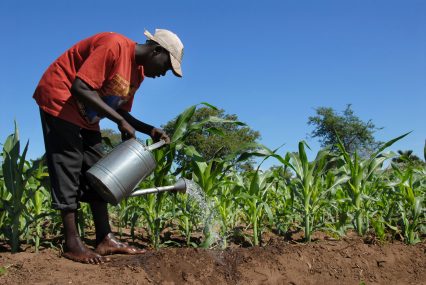Commodity exchanges and warehouse receipt programmes are being set up across East Africa, making the agri-commodities a more attractive sector to finance. Nick Wadhams reports.
In western Kenya, the average farmer is so cut off from markets – for everything from maize to cows to rice – that one trade group took to the radio waves two years ago to set up a basic but effective exchange.
Known as Supermarket On Air, the programme, which broadcasts in western Kenya every day from 9 to 10am, takes calls from farmers looking to sell a goat, or offload a tonne of maize, and broadcasts the offers on the air. Interested listeners call in, and Supermarket on Air puts them together.
“It’s basically a virtual market,” says Adrian Mukhebi, chairman of the Kenya Agricultural Commodity Exchange (Kace) in Nairobi. “We would really like to be able to scale this up to a national level across surplus and deficit areas. This is one innovation that we think has the potential to help small farmers link to markets.”
By June of this year, Mukhebi’s Kace hopes to take the principles behind Supermarket On Air to an entirely new level, with the creation of a commodities exchange for all of East Africa. The exchange, which will begin by trading in maize, rice, wheat and possibly beans, is part of larger, region-wide efforts to get small-scale farmers, who may own just a few acres of land, to move from subsistence farming to selling their crops at profit.
The effort to build the exchange comes as Kenya is piloting a warehouse receipts programme by which farmers can store their harvest at a certified warehouse and sell when prices rise. The warehousing system can also turn their commodity into collateral if they choose to apply for a loan.
“If farmers are able to increase their income, they’ll be able to afford inputs such as high-yield seeds and increase agricultural production,” Mukhebi says. “If increased agricultural production is in turn marketed at better prices, we think this is the wealth creation spiral that will help farmers out of the poverty trap.”
Analysts and bankers say the East African exchange experiment is part of larger efforts in the region, and across the continent, to help farmers come together to sell their commodities at a profit and to introduce agricultural mechanisms common in the rest of the world, such as crop insurance and warehousing. This will help them gain collateral, and then loans to expand their businesses.
One of the most prominent regional examples is Ethiopia, which set up a commodities exchange for coffee, beans, maize and a few other crops in April 2008. The exchange, supported by funding from the UN development programme (UNDP) and the World Bank, among others, is meant to increase food security in a country that has been plagued by drought and hunger, and expand markets for the small-scale farmers who produce 95% of the country’s agricultural output.
“The small-scale farmers came to the market when they did – if they did at all – with very little information and were very much at the mercy of the merchant traders,” says Sam Nyambi, UNDP’s head of office in Addis Ababa. “They were unable to negotiate better prices and generally had no sense of what was prevailing in the rest of the country.”
By the end of this year, India-based Financial Technologies is looking to establish a pan-African commodities exchange called Bourse Africa that will, backers say, give Africa a voice in determining the price for goods exported from the continent, rather than relying on the dictates of exchanges in London or Chicago.
“Why do we have to make London the reference point?” says Chris Goromonzi, managing director of Bourse Africa. “What we need to do is to let the African commodities be traded when Africa is awake. Right now, what’s happening is that African commodities are being traded while we are sleeping. What we are saying is ‘let’s give Africa a voice’.”
Meeting rising demand
Driving the increased sophistication is the surging demand around the world for African commodities.
According to the Food and Agriculture Organisation, Africa has about 15% of the world’s arable land and only 14% of those 184 million hectares is now under cultivation. Rising demand for commodities by Middle Eastern nations and the BRIC countries – Brazil, Russia, India and China – means that investors are looking to back agricultural projects in Africa more than ever before.
“There’s a huge natural requirement for food and that’s going to be ongoing, and Africa and Latin America, I think, are increasingly going to be required to produce a bigger proportion of the world’s food consumption,” says Craig Polkinghorne, global head and direct of structured trade and commodity finance at Standard Bank. “It’s not going to happen overnight, it’s going to happen over years, but I think there will be pressure to commercialise, pressure to become increasingly sophisticated and there will be sufficient funding if those initiatives are put in place.”
Headline-grabbing land purchases by Middle Eastern investment funds made the news in 2007 and 2008, and while those sorts of deals continue, the focus now is on investing in big commercial farms and investing in development amongst small-scale farmers. With land ownership such an emotive issue here, snapping up African land is seen as politically risky compared to putting money in pre-existing, African-owned ventures.
Investors and banks are also looking at ways to pull subsistence farmers into the realm of commercial farming and then increase food security for others, not just themselves.
Standard Bank’s Polkinghorne recently partnered with the Alliance for a Green Revolution in Africa (AGRA) to lend US$100mn over three years to small-scale farmers in Mozambique, Uganda, Tanzania and Ghana. It hopes that the money will help 750,000 farmers.
Others are working to train subsistence farmers about crop rotation, soil analysis and planting techniques to increase the productivity of their land.
“When you get into Africa, there is a lot of training to show subsistence farmers that you can make a profit,” says Peter Martin, director of new business development and investments at service provider, Farmsecure Holdings, in South Africa. “How do you combine subsistence farmers into cooperatives so they can produce more than they need? That means they need financing and technology.”
Farmsecure seeks to “provide farmers with precision farming skills, agricultural knowledge, cost-effective supply chain management and hands-on support to assist the farmers in fulfilling their potential whilst creating above average shareholder wealth.” And it hopes to bring that model to the rest of the continent from South Africa, where farming is much further along, and far more sophisticated.
“You’ve got price risk and commodity risk. So long as you can manage those two you’ve got a huge possibility of producing,” says Martin.
“Now you can bring economies of scale in, you can bring tractors in, harvesters in. Then you educate subsistence farmers, tell them that they don’t have to be only subsistence farmers, that they can make profits. And if they work together, they can produce far in excess of their needs.”
Ugandan developments
One country that is providing hope for the rest of Africa outside South Africa is Uganda, which is already showing how to give farmers more power, and more access to the market. Thanks to a maturing warehouse system, farmers have begun to form cooperatives to pool their products such as cotton or maize and avoid financial disaster should they be struck by drought or crop failure.
One company leading the way is the Coronet Group, which offers collateral management and advice on trade finance, among many other services. The group says that its warehouse receipts system caters to farmers who are still working very much in the short term – they may take out loans to pay school feels or medical bills or inputs for the next planting season.
That gives farmers breathing room, as well as the option not to sell their maize at harvest time, when everyone else is selling and prices are low.
“This actually works because, for example, last season we were buying maize at 300 shillings per kilo,” says Christian Baine, Coronet’s executive director. “Three months down, the farmers sold their maize to the World Food Programme at 795 shillings, which is incredible because this is a kind of premium they’ll never get. We’re seeing a lot of interest countrywide from farmers in this system.”
The case of Coronet provides a neat little example for how such a system can lead to wider reform in the agricultural finance sector. More farmers looking to warehouse their commodities and take out loans has spurred the country’s banks to think more about offering useful financial products.
Whereas farmers once may have struggled to find someone willing to cater to their needs, these days they have a plethora of choices.
“Just two years ago, we didn’t even have one bank that was willing to finance farmers against commodities – or anything else for that matter,” Baine says. “A few banks were coming in to finance production, but when it came to trade for working capital, for trading, for marketing, no bank was involved.
“Today, we have nearly five commercial banks that have products for farmers where their warehouse receipts can be discounted. I think that is a powerful benefit for farmers.”
It is developments like these that are making analysts and bankers excited about the potential for agriculture in Africa. Storing commodities such as cotton in certified warehouses eliminates a range of risks. It guarantees quality, for one thing. For another, it guarantees that the crop is secure.
Those two factors can open the door to more financing from banks around the world, not just in the region, says Abah Ofon, a commodities researcher at Standard Chartered Bank in Dubai.
“My view would be that warehousing schemes would facilitate financing,” Ofon says. “Warehousing is a big issue. Quality is a big issue. Security is a big issue. Securitising the commodities is a big issue and often stands in the way of financing. I would say it’s in the same vein as setting up an exchange. It’s in a very rudimentary form, so I would think it would be a positive development.”
Positive developments and upbeat assessments are one thing. But the unique challenges facing African countries, however, underscore the challenges that investors will face entering the African market, and the contrary pressures that will face anyone looking to lift the agricultural sector to a position where it can start supplying enough food to international markets to make a difference.
Mismanagement
First is the uncomfortable fact that much of Africa is deeply poor and even people in countries with relatively strong economies and fertile land, such as Kenya, suffer severe famine. The outcry that might arise from exporting food from a country undergoing a hunger crisis may be too much for an investor to bear.
The problems of hunger, and even drought, often have their roots in political corruption, poor farming practices and mismanagement, and could be avoided if there were more transparency and if regulations were adhered to.
Kenya is a perfect example. According to the World Food Programme, 1.6 million people in the country need food assistance, largely because harvests failed after severe drought in 2008 and 2009.
But that’s not the whole story. The shortage was caused in large part by disruptions to the planting season that resulted from post-election violence in early 2008. Then, the country had a bumper maize harvest early this year. Much of that maize rotted in warehouses because millers and middlemen could not sell it in time, or did not know where demand was highest, such as in the western part of the country.
“The government was caught napping,” says Booker Owuor, an agricultural research consultant with Sower Solutions in Kenya.
“Maize was left rotting, farmers were selling at throwaway prices.”
That failure in the market followed close on the heels of a maize scandal that rocked the country last year. In that scheme, maize that was part of the government’s strategic reserve, which was meant to be released to keep maize prices down for the public, was awarded to members of parliament and prominent businessmen who then sold it on at inflated prices.
Kenyan farmers are also suspicious of joining together to form cooperatives because they fear that the leaders of the group will try to steal their money. That makes it hard for small-scale farmers to pull together to put their crops in a warehouse system.
“Kenya has lost a lot of money because of the corruption scandals going on day in, day out,” says Owuor. “I was in Germany in January, and everybody else was saying we cannot continue sending money to individual pockets, we cannot continue sending money to benefit a few powerful people in the government. If we cannot find any other way, we will be done with it.”
That kind of corruption has led people such as Owuor to fear that countries may use commodities exchanges and warehousing programmes simply as other tools to exert corruption and exercise their own power.
The Kenyan government may decide, for example, to impose a ban on imported maize, and how will that affect the commodities exchange?
Critics of Ethiopia
Another example is Ethiopia. Its commodities exchange has been hailed as a great step forward, yet critics say that the price information it offers small-scale farmers is largely useless when huge swathes of the country have no electricity and no way of getting the information.
Other critics argue that it is limiting some exporters’ access to markets and is more a means for the Ethiopian government to control coffee trading than it is to create a free market.
“Since its establishment, which began its operation in April 2008, the Ethiopian commodities exchange has never been a free exchange market,” Seid Hassan, a professor of economics at Murray State University in the United States, wrote in an article last year. “The description ‘free commodity exchange market’ was and still is just a PR stunt and a pretext to hoodwink donors and unsuspecting public.”
On the larger level, there are also skeptics of wider, pan-African exchanges such as Bourse Africa. One such doubter is Andrew Barr-Sim, managing director of Drum Resources in the UK.
Barr-Sim fears that an African exchange will only compete with pre-existing international exchanges, and will be tough to manage in a continent with so many different currencies and languages. But his bigger fear is that farmers who, in places like Kenya, still rely on the radio to buy and sell and may not have the technology or the tools to use an exchange properly.
“It just flies against international trade,” said Barr-Sim. “Imagine a small grower of tea in your backyard. Does he speak fluent English?Does he have access to the Internet so he can check international tea prices? Does he sell in shillings or dollars, and hedge his futures? Can he pay international freight rates? Has he the necessary finance to put it in a container?”
Exchange proponents, both in Addis Ababa and across the rest of Africa, say they’ve thought of those problems and believe an African system can overcome them.
“Through our engagement with various countries, there is a lot of interest and we believe most of those issues will be resolved,” says Goromonzi of Bourse Africa. “Once we start getting better prices in Africa, once we demonstrate the benefits that exchanges bring, some of those issues will be easier to manage.” GTR





